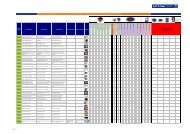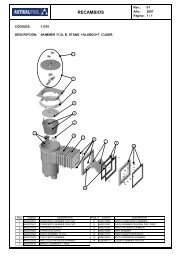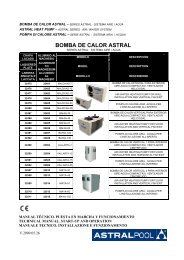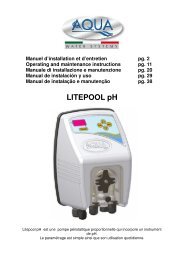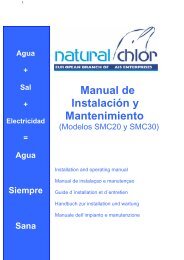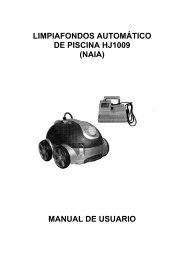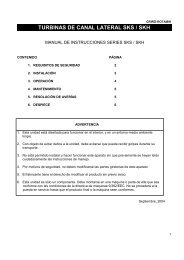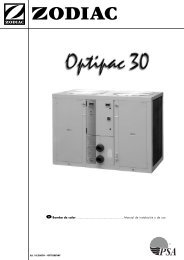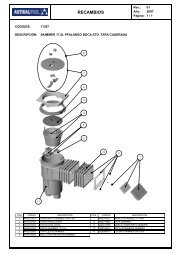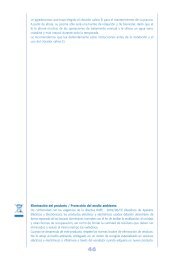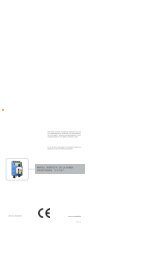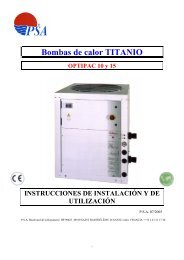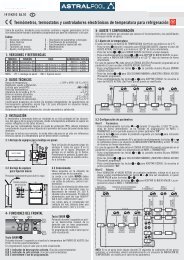ENFRIADORA AIRE/AGUA EF COMPACTA - Ferromar
ENFRIADORA AIRE/AGUA EF COMPACTA - Ferromar
ENFRIADORA AIRE/AGUA EF COMPACTA - Ferromar
Create successful ePaper yourself
Turn your PDF publications into a flip-book with our unique Google optimized e-Paper software.
<strong>ENFRIADORA</strong> <strong>AIRE</strong>/<strong>AGUA</strong> – SERIES <strong>EF</strong> · SISTEMA <strong>AIRE</strong>/<strong>AGUA</strong>AIR/WATER COOLER <strong>EF</strong> – <strong>EF</strong> SERIES · AIR/WATER SYSTEM<strong>ENFRIADORA</strong> <strong>AIRE</strong>/<strong>AGUA</strong> <strong>EF</strong> <strong>COMPACTA</strong>SERIES <strong>EF</strong> · SISTEMA <strong>AIRE</strong>/<strong>AGUA</strong>MODELO / MODEL CÓDIGO / CODEALASKA-4 32535ALASKA-6 32536ALASKA-8 32537ALASKA-10 32538ALASKA-12 32539ALASKA-15 32540ALASKA-17 32541MODELO / MODEL CODIGO / CODESIBERIA-4 33301SIBERIA-6 33302SIBERIA-8 33303SIBERIA-10 33304SIBERIA-12 33305SIBERIA-15 33306SIBERIA-17 33307MANUAL TÉCNICO. PUESTA EN MARCHA Y FUNCIONAMIENTOTECHNICAL MANUAL. START-UP AND OPERATIONV.2009.10.02
<strong>ENFRIADORA</strong> <strong>AIRE</strong>/<strong>AGUA</strong> <strong>EF</strong> <strong>COMPACTA</strong>SERIES <strong>EF</strong> · <strong>ENFRIADORA</strong> DE PISCINA<strong>ENFRIADORA</strong> <strong>AIRE</strong>/<strong>AGUA</strong> – SERIES <strong>EF</strong> · SISTEMA <strong>AIRE</strong>/<strong>AGUA</strong>AIR/WATER COOLER <strong>EF</strong> – <strong>EF</strong> SERIES · AIR7WATER SYSTEMTECHNICAL MANUAL. START-UP AND OPERATIONMANUAL TÉCNICO. PUESTA EN MARCHA Y FUNCIONAMIENTO
ESPAÑOLINDICE1. INTRODUCCION ............................................................................................................................ 062. MODELOS ....................................................................................................................................... 073. PRECAUCIONES DE EMPLEO Y CONDICIONES DE USO ......................................................... 073.1 Descripción ............................................................................................................................... 073.2 Descripción del equipo ............................................................................................................. 073.3 Cuadro eléctrico ........................................................................................................................ 074. CARACTERISTICAS TECNICAS ................................................................................................... 085. POTENCIA ENTREGADA Y CONSUMIDA .................................................................................... 086. ESQUEMA DE DIMENSIONES ...................................................................................................... 087. CARACTERISTICAS ELECTRICAS ............................................................................................... 098. REGULADOR .................................................................................................................................. 099. PRECAUCIONES GENERALES..................................................................................................... 1510. COMPROBACION DEL EMBALAJE .............................................................................................. 1611. CONDICIONES DE TRABAJO ....................................................................................................... 1612. REQUISITOS Y OPERACIONES PREVIAS ................................................................................... 1613. CONEXIONES ELECTRICAS ......................................................................................................... 1714. CONEXIONES HIDRAULICAS ....................................................................................................... 1915. OPERACIÓN DE PUESTA EN MARCHA ....................................................................................... 2016. MANTENIMIENTO PREVENTIVO .................................................................................................. 2017. AVERIAS, SUS CAUSAS Y SOLUCIONES ................................................................................... 2118. CARGA DE GAS R<strong>EF</strong>RIGERANTE ................................................................................................ 2319. GARANTIA Y CONDICIONES GENERALES ................................................................................. 2520. RECICLAJE DEL PRODUCTO ....................................................................................................... 26© TALLERES DEL <strong>AGUA</strong> S.L. 2008. TODOS LOS DERECHOS RESERVADOS. DOCUMENTO CONFIDENCIAL Y EN PROPIEDAD.Page 4 of 50
ENGLISHINDEX1. INTRODUCTION ............................................................................................................................. 282. MODELS ......................................................................................................................................... 293. GENERAL FEATURES ................................................................................................................... 293.1 Description ................................................................................................................................ 293.2 Description of equipment .......................................................................................................... 293.3 Electrical panel .......................................................................................................................... 294. TECHNICAL CHARACTERISTICS ................................................................................................. 305. GIVEN AND CONSUMED POWER ................................................................................................ 306. DIMMENSIONS DATA .................................................................................................................... 307. ELECTRICAL CHARACTERISTICS ............................................................................................... 318. REGULATOR .................................................................................................................................. 319. GENERAL PRECAUTIONS ............................................................................................................ 3710. PACKAGING INSPECTION ............................................................................................................ 3811. OPERATING CONDITIONS ............................................................................................................ 3812. REQUIREMENTS AND PROCEDURES ........................................................................................ 3813. ELECTRICAL CONNECTIONS ....................................................................................................... 3914. HYDRAULIC CONNECTIONS ........................................................................................................ 4115. PROCEDURES AND START-UP ................................................................................................... 4216. PREVENTIVE MAINTENANCE ...................................................................................................... 4317. TROUBLESHOOTING GUIDE ........................................................................................................ 4418. R<strong>EF</strong>IREGERANT GAS CHARGE ................................................................................................... 4519. WARRANTY AND GENERAL CONDITIONS ................................................................................. 4720. PRODUCT RECYCLING ................................................................................................................. 48© TALLERES DEL <strong>AGUA</strong> S.L. 2008. TODOS LOS DERECHOS RESERVADOS. DOCUMENTO CONFIDENCIAL Y EN PROPIEDAD.Page 5 of 50
ESPAÑOL<strong>ENFRIADORA</strong> <strong>AIRE</strong>/<strong>AGUA</strong> <strong>EF</strong> <strong>COMPACTA</strong>SERIES <strong>EF</strong>Sistema Aire/Agua1. INTRODUCCIÓNGracias por adquirir la <strong>ENFRIADORA</strong> <strong>AIRE</strong>-<strong>AGUA</strong> <strong>EF</strong> fabricada por Talleres del Agua. Laexperiencia acumulada por nuestra compañía durante más de 20 años en el mundo de laclimatización de piscinas ha sido puesta a su servicio en este producto.IMPORTANTELe rogamos al cliente o instalador lea detenidamente este manual con el fin de:• Realizar una correcta instalación y puesta en marcha.• Conocer todas las potencialidades de la máquina, y tener en cuenta todas lascircunstancias necesarias para su correcto y duradero funcionamiento.LE RECOMENDAMOS ANOTE LOS SIGUIENTES DATOSAPARATONº R<strong>EF</strong>ERENCIA MODELOINSTALADORNOMBREPOBLACIÓNDOMICILIOTELÉFONOFECHA DE PUESTA EN MARCHAUSUARIONOMBREPOBLACIÓNDOMICILIOTELÉFONOFECHA DE PUESTA EN MARCHA(A rellenar por el instalador) SELLO DEL INSTALADOR:Para todas las máquinas, se deberá cumplimentary enviar esta tarjeta de garantía para que entre en vigor© TALLERES DEL <strong>AGUA</strong> S.L. 2008. TODOS LOS DERECHOS RESERVADOS. DOCUMENTO CONFIDENCIAL Y EN PROPIEDAD.Page 6 of 50
ESPAÑOL2. MODELOS<strong>ENFRIADORA</strong>MODELOPOTENCIAFRIGORIFICA (KW)<strong>EF</strong>-4 5,53<strong>EF</strong>-6 8,30<strong>EF</strong>-8 11,59<strong>EF</strong>-10 15,44<strong>EF</strong>-12 17,35<strong>EF</strong>-15 31,02<strong>EF</strong>-17 29,753. CARACTERISTICAS GENERALES3.1 DescripciónLA <strong>ENFRIADORA</strong> <strong>AIRE</strong>-<strong>AGUA</strong> <strong>EF</strong> se utiliza para el enfriamiento del vaso de piscina, piletas deagua fría, etc.3.2 Descripción del equipoLA <strong>ENFRIADORA</strong> <strong>AIRE</strong>-<strong>AGUA</strong> <strong>EF</strong> está equipada con los siguientes elementos:* Robusto y ligero diseño en chapa lacado o aluminio al magnesio con su posible colocación enzonas interiores o exteriores al aire libre.* Batería condensadora de alto rendimiento fabricada en tubo de cobre y aletas de aluminio lacado,especiales para ambientes corrosivos y de costa.* Ventilador axial con motor de acoplamiento directo ( Colocación de maquina en exteriores ).* Ventilador centrifugo (Colocación de maquina en interiores ).* Compresor Hermético con protección interna, resistencia de carter y silenciador.* Evaporador de Agua (intercambiador de calor agua-agua)* Presostatos de Alta y Baja Presión (AP/BP) de rearme manual.* Expansión mediante Válvula Termostática con equilibrador externo.* Filtro deshidratador.* Circuito hidráulico con interruptor de flujo en la entrada de agua, fabricado en tubería de PVC dealto peso molecular, buena elasticidad y notable resistencia a las fisuras bajo tensión, característicafundamental para el transporte de líquidos bajo presión.* Carga completa de gas refrigerante R-407-C.* Un circuito frigorífico de cobre nitrogenado, deshidratado y desoxidado.3.3 Cuadro eléctricoCuadro eléctrico con control total para garantizar un rendimiento optimo con un mínimo consumode energía en todo momento. Compuestos por los siguientes elementos:* Interruptor Marcha/Paro.* Temporizador electrónico del compresor.* Contactores y relé térmico.* Bornas de interconexión y de tierra.* Controlador.© TALLERES DEL <strong>AGUA</strong> S.L. 2008. TODOS LOS DERECHOS RESERVADOS. DOCUMENTO CONFIDENCIAL Y EN PROPIEDAD.Page 7 of 50
ESPAÑOL4. CARACTERISTICAS TECNICASCIRCUITO EXTERIOR (<strong>AIRE</strong>)MODELOALASKASIBERIAm3/h Nº VENT. m3/h Nº VENT.<strong>EF</strong>-4 3.800 1 3.800 1<strong>EF</strong>-6 4.900 1 4.900 1<strong>EF</strong>-8 5.500 1 5.500 1<strong>EF</strong>-10 9.800 2 9.800 1<strong>EF</strong>-12 9.800 2 9.800 1<strong>EF</strong>-15 11.000 2 11.000 1<strong>EF</strong>-17 11.000 2 11.000 1MODELOCIRCUITO INTERIOR (<strong>AGUA</strong>)CAUDAL (L/h) CONEXIÓN HIDRAULICA Kpa<strong>EF</strong>-4 6.000-10.000 1 ½´´-(Ø50mm) 14,3<strong>EF</strong>-6 6.000-10.000 1 ½´´-(Ø50mm) 19,1<strong>EF</strong>-8 7.000-12.000 1 ½´´-(Ø50mm) 23,1<strong>EF</strong>-10 7.000-12.000 1 ½´´-(Ø50mm) 33,4<strong>EF</strong>-12 7.000-12.000 1 ½´´-(Ø50mm) 26,5<strong>EF</strong>-15 10.000-15.000 2´´-(Ø63mm) 31,1<strong>EF</strong>-17 10.000-15.000 2´´-(Ø63mm) 38,95. POTENCIA ENTREGADA Y CONSUMIDAPOTENCIASMODELO POTENCIA FRIGORIFICA (KW) POTENCIA CONSUMIDA (KW)<strong>EF</strong>-4 5,53 1,9<strong>EF</strong>-6 8,30 2,5<strong>EF</strong>-8 11,59 3,4<strong>EF</strong>-10 15,44 4,4<strong>EF</strong>-12 17,35 5<strong>EF</strong>-15 31,02 6,1<strong>EF</strong>-17 29,75 6,76. ESQUEMA DE DIMENSIONESDIMENSIONES STANDARD (mm)MODELOLARGO ANCHO ALTOALASKA SIBERIA ALASKA SIBERIA ALASKA SIBERIA<strong>EF</strong>-4 1.215 1.215 460 510 750 750<strong>EF</strong>-6 1.315 1.315 460 650 750 750<strong>EF</strong>-8 1.405 1.405 455 650 845 860<strong>EF</strong>-10 1.455 1.900 655 800 895 1.100<strong>EF</strong>-12 1.455 1.900 655 800 895 1.100<strong>EF</strong>-15 1.805 1.900 705 800 850 1.100<strong>EF</strong>-17 1.805 1.900 705 800 850 1.100© TALLERES DEL <strong>AGUA</strong> S.L. 2008. TODOS LOS DERECHOS RESERVADOS. DOCUMENTO CONFIDENCIAL Y EN PROPIEDAD.Page 8 of 50
ESPAÑOL7. CARACTERISTICAS ELECTRICASINTENSIDAD ABSORBIDA (A)MODELOALASKASIBERIAI/220/50 III/380/50 I/220/50 III/380/50<strong>EF</strong>-4 10,60 - 14,65 -<strong>EF</strong>-6 14,8 - 19,11 -<strong>EF</strong>-8 - 7,8 - 12,80<strong>EF</strong>-10 - 8,97 - 10,27<strong>EF</strong>-12 - 12,13 - 13,43<strong>EF</strong>-15 - 12,13 - 13,43<strong>EF</strong>-17 - 15,40 - 16,708. REGULADORCROUZETEn primer lugar nada mas encender el equipo aparece la siguiente pantalla.Con las teclas A-B pulsadas a la vez el quipo se pone en marcha. Si mantenemos pulsada la teclade ESC durante 5 segundos el equipo se apaga.En esta pantalla podemos ver:• Temperatura de agua• Estado de circulación de agua.• Estado del compresor (maquina calentando)Para acceder a las demás pantallas debemos presionar las teclas + y -.Presionando sobre la tecla +, nos aparece la siguiente pantalla.Si presionamos sucesivas veces la tecla +, el asterisco va desplazándose en los submenúscorrespondientes. Una vez alcanzado el submenú deseado pulsamos la tecla OK, con la que© TALLERES DEL <strong>AGUA</strong> S.L. 2008. TODOS LOS DERECHOS RESERVADOS. DOCUMENTO CONFIDENCIAL Y EN PROPIEDAD.Page 9 of 50
ESPAÑOLconfirmamos su entrada. A continuación se muestran las pantallas correspondientes a cadasubmenú y los datos visibles.Menú CONSIGNAS:Valor modificable. Para modificar este valor basta con presionar las teclas + o – en relación a latemperatura que se quiera establecer. Una vez modificada para confirmar presionamos OK y ESCpara volver al menú principal. Los valores modificables en este campo oscilan entre 10 y 45grados.Menú TEMPERATURAS:En este menú podemos observar:• Temperatura agua.• Temperatura desescarche.Estos datos no son modificables en esta pantalla. La Temperatura de desescarche no se puedemodificar en este submenú.Menú ESTADOS:En este submenú podemos ver:• Estado compresor• Estado ventilador• Estado depuradora© TALLERES DEL <strong>AGUA</strong> S.L. 2008. TODOS LOS DERECHOS RESERVADOS. DOCUMENTO CONFIDENCIAL Y EN PROPIEDAD.Page 10 of 50
ESPAÑOLEstos datos cambian de estado cuando el elemento entra en funcionamiento. Es un menú sólo delectura.Menú ALARMAS:En este submenú podemos observar:• Alarma baja presión• Alarma Alta presión• Alarma CaudalLa alarma de caudal nos indica el estado del caudal de agua que pasa por la maquina es suficienteo no. Las alarmas de baja y alta presión van relacionadas con el siguiente submenú. Es un menúsólo de lectura.Menú REARME:En este menú podemos observar:Este menú es modificable solo cuando alguna de las alarmas de baja o alta presión ha saltado tresveces. Cuando el asterisco esta en alarma saltada la maquina no volverá a arrancar hasta que no serearme. Para rearmarla basta con presionar la tecla de + y volvemos el asterisco a la posición derearme de alarma. Si apretamos OK entonces la maquina comienza el ciclo de funcionamiento.Con la tecla ESC retrocedemos al menú inicial.Menú CALIBRACIÓN:Posicionando el cursor sobre el menú calibración y pulsando OK, nos aparece el siguientesubmenú para configurar el equipo.© TALLERES DEL <strong>AGUA</strong> S.L. 2008. TODOS LOS DERECHOS RESERVADOS. DOCUMENTO CONFIDENCIAL Y EN PROPIEDAD.Page 11 of 50
ESPAÑOLIntroduciendo la clave de acceso podremos entrar en la configuración del equipo. Póngase encontacto con el servicio técnico para conseguirla.En este submenú los parámetros son modificables.• Fin de desescarche: Esta constante de temperatura es la que indica la finalizacióndel desescarche.• INI desescarche: Constante por la que se indica la temperatura en la que se activa eldesescarche.• Cal Sonda: Constante que se utiliza para la calibración de la sonda de temperaturade agua.Para salir de esta pantalla basta con presionar ESC.Menú FECHA/HORA:Menú modificable. En este menú se puede ajustar la fecha y la hora del equipo.Menús de ajuste de modo de trabajo del Equipo.Menú Selección de modo Manual/Automático.A este menú se accede desde cualquier menú manteniendo la tecla de OK presionada durante 5seg.La elección del modo automático conlleva el ajuste en el menú de programación de horas defuncionamiento.© TALLERES DEL <strong>AGUA</strong> S.L. 2008. TODOS LOS DERECHOS RESERVADOS. DOCUMENTO CONFIDENCIAL Y EN PROPIEDAD.Page 12 of 50
ESPAÑOLMenú PROGRAMACIÓN:A este menú se accede manteniendo pulsadas las teclas de ESC y OK y aparece la pantallasiguiente.Los valores que aparecen en esta pantalla son los siguientes:BDF: Indica la constante a modificar• 000, con esta constante modificamos el horario de funcionamiento• 014, esta constante varia la temperatura de consigna.• 124,constante de ajuste temperatura de inicio desescarche• 139, constante de fin de desescarche• 238, constante de calibración de sonda.Al entrar en este menú por defecto entramos en la modificación de constantes de programaciónhoraria.Modo de ajuste de programación horaria:Nú:00, nú:01, nú:02 y nú: 04Son parámetros en los que se ajustan los arranques y paradas en relación a una hora prefijada porel cliente. También cave la posibilidad de modificar el día de la semana y la semana del mesconcreta.Para realizar estas modificaciones basta con posicionarse con el cursor sobre el campo a programary pulsar OK, una vez seleccionado con las tecla + ó -, variamos el ajuste.En el campo de los días de la semana., D:LMMJVSD, una vez posicionado (teclas +,-) sobre el,presionamos la tecla OK y este campo comienza a parpadear. A medida que pulsamos sobre latecla de OK el cursor va avanzando sobre los diferentes días de la semana y con las teclas +,-podemos anular el día de programación o activarlo según la programación deseada. Lo mismoocurre con el campo de semanas del mes (S:12345). En este campo se pueden programar lassemanas en que queremos que el equipo funcione.Para salir de este menú pulsamos la tecla de ESC y volvemos al menú principal.© TALLERES DEL <strong>AGUA</strong> S.L. 2008. TODOS LOS DERECHOS RESERVADOS. DOCUMENTO CONFIDENCIAL Y EN PROPIEDAD.Page 13 of 50
ESPAÑOLREGULADOR ELECTRONICO DIGITALOSAKA OT31 AZI. DESCRIPCIÓN GENERALEl modelo OT 31 Z / OT 31 Al es un regulador digital que se utiliza en aplicaciones derefrigeración, dotado de control de temperatura tipo ON/OFF y control de descarche con intervalosde tiempo mediante parada del compresor. El instrumento tiene 1 salida relé y una entradaconfigurable para sonda de temperatura PTC o NTC. Tiene 4 teclas de programación, un displaycon 4 dígitos y 2 led de señalización. Otras características son: protección de los parámetros deprogramación mediante password personal, arranque y paro (stand-by) mediante la tecla "F", laconfiguración de los parámetro mediante el dispositivo COPY KEY y alimentación dentro delrango 100...240 VAC.II. DESCRIPCIÓN DEL PANEL FRONTAL1 - Tecla set: Permite programar el Set point y los parámetros de funcionamiento.2 - Tecla DOWN: Permite decrementar los valores de programación y la seleccionar de losparámetros.3 - Tecla UP/D<strong>EF</strong>ROST: Permite incrementar los valores de programación, seleccionar losparámetros y activar el descarche manual.4 - Tecla F: Programable mediante el parámetro "USrb" para actuar como ON/OFF(Stand-by). Enla modalidad de programación de los parámetros ocultos, se utiliza para modificar la visibilidad delos parámetros.5 - Led sET: Indica que se está en la modalidad de programación y el nivel de programación deparámetros. Además indica que el equipo está en estado de Stand-by.6 - Led OUT: Indica el estado de la salida del compresor (o del dispositivo de control de latemperatura): on (encendido), off (apagado) o inhibida (en intermitencia)7 - Led D<strong>EF</strong>: Indica que se está ejecutando el descarche.III. TABLA DE PARAMETROS PROGRAMABLES.A continuación se describen todos los parámetros que el instrumento puede tener. Algunos de ellosno estarán presentes porque dependen del tipo de instrumento utilizado o porque se inhabilitanautomáticamente ya que son parámetros no necesarios.IMPORTANTE: En la siguiente tabla se mostrarán sólo los parámetros visibles. Hay además unaserie de parámetros que están ocultos y que sólo se podrá acceder a ellos procediendo con elmétodo LOCK. Estos parámetros se muestran en la tabla de parámetros ocultos.© TALLERES DEL <strong>AGUA</strong> S.L. 2008. TODOS LOS DERECHOS RESERVADOS. DOCUMENTO CONFIDENCIAL Y EN PROPIEDAD.Page 14 of 50
ESPAÑOLIV. SEÑALES DE ERROR.9. PRECAUCIONES GENERALES* Las operaciones de instalación, puesta en marcha y mantenimiento de la <strong>ENFRIADORA</strong> <strong>AIRE</strong>-<strong>AGUA</strong> COMPISA <strong>EF</strong> deben ser realizadas por personal cualificado.* No se debe de instalar estos equipos en entornos inflamables o explosivos.* Para cualquier operación de mantenimiento dentro de la máquina, se tendrá la precaución dedesconectar la corriente eléctrica en el seccionador principal.* En las operaciones de mantenimiento es obligatorio el uso de equipos de protección o seguridadcomo gafas, guantes, etc.* Durante el funcionamiento de la máquina es habitual que las condensaciones que se producen enla evaporadora hagan que salga una cantidad de agua de la máquina que hay que evacuar. Lasmáquinas vienen provistas de un desagüe en un lateral de la carcasa, que siempre debe quedar librede cualquier obstrucción. El agua de condensación no tiene que ser tratada de una forma especial.© TALLERES DEL <strong>AGUA</strong> S.L. 2008. TODOS LOS DERECHOS RESERVADOS. DOCUMENTO CONFIDENCIAL Y EN PROPIEDAD.Page 15 of 50
ESPAÑOL10. COMPROBACIÓN DEL EMBALAJE<strong>ENFRIADORA</strong> <strong>AIRE</strong>-<strong>AGUA</strong> <strong>EF</strong> se presenta con un EMBALAJE RECICLABLE capaz deresistir unas duras condiciones de transporte. No obstante, durante la instalación de la misma sedeberá efectuar una comprobación visual de cualquier desperfecto, de forma que se evite cualquiermal funcionamiento posterior.TALLERES DEL <strong>AGUA</strong> no asumirá responsabilidad en ese caso.¡ATENCIÓN!ES MUY IMPORTANTE NO INCLINAR EL EMBALAJE, PARA LO QUE ÉSTE SE DISEÑÓCONVENIENTEMENTE. SIEMPRE SE DEBERÁ MANTENER EN POSICIÓN VERTICAL.SI LA UNIDAD ESTÁ DAÑADA, O SI EL ENVIO NO ESTA COMPLETO, ANOTAR EN ELALBARÁN DE ENTREGA Y ENVIAR UNA RECLAMACIÓN INMEDIATA A LA COMPAÑÍA QUEREALIZÓ EL ENVÍO.En su interior encontrará los siguientes elementos:<strong>ENFRIADORA</strong> <strong>AIRE</strong>-<strong>AGUA</strong> <strong>EF</strong>Manual de Instalación.Garantía.11. CONDICIONES DE TRABAJOLos parámetros físicos y químicos del agua deben de estar en los siguientes valores:PH 7,2 a 7,8Cloro residual1 a 2 ppmAlcalinidad80-125 ppmSólidos totales disueltos
ESPAÑOL* Siempre se debe de colocar la máquina en posición vertical ynivelada.* Esta máquina está pensada para trabajar en interiores si poseeventilador centrifugo, o en exteriores si posee ventilador axial.* Se debe prever un espacio alrededor del equipo para sumantenimiento y funcionamiento además de comprobar que laentrada y salida de aire no estén obstruidas.* En la colocación exterior prevean no ubicar la máquinadebajo de un tejado muy inclinado para evitar el exceso deagua cayendo desde desagües.* No es recomendable colocar la máquina 1,5 metros porencima de la lámina de agua, ni 3 metros por debajo.* Durante su funcionamiento podrá aparecer agua decondensación producida por el evaporador. Para ello lamáquina dispone de un salida de evacuación en un lateral.* Para evitar cualquier proceso corrosivo en la batería condensadora no se podrá instalar la unidaden ambiente ácido o alcalino.13. CONEXIONES ELECTRICASLa acometida eléctrica deberá ser realizada por un instalador partiendo de una instalación quetenga los siguientes componentes:* Interruptor diferencial.* Automáticos o Magnetotérmicos.En el cuadro que se representa a continuación se indica esquemáticamente el modo en el que debehacer la conexión.Comprobar siempre que la tensión de red se corresponde con la de la máquina en la chapa decaracterísticas técnicas.Se instalarán cables cuya sección cumpla con las normativas actuales e impidan un calentamientode estos y una caída de tensión. A titulo orientativo se puede usar la tabla para longitudes menoresde 5 metros. En todo momento se cumplirá la normativa vigente y los criterios del proyectista.© TALLERES DEL <strong>AGUA</strong> S.L. 2008. TODOS LOS DERECHOS RESERVADOS. DOCUMENTO CONFIDENCIAL Y EN PROPIEDAD.Page 17 of 50
ALIMENTACION GENERALMODELOSECCIÓN (mm2)VOLTAJE (V) Long. 40 mts max. Nº DE HILOSALASKA SIBERIA<strong>EF</strong>-42.5220 II<strong>EF</strong>-6 42 + TIERRA<strong>EF</strong>-8<strong>EF</strong>-102.5<strong>EF</strong>-12<strong>EF</strong>-15<strong>EF</strong>-17380 III 2,5 4 + TIERRAESPAÑOLEl regulador y el interruptor PARO / MARCHA se encuentra en el interior de la Enfriadora conventilador axial, para su acceso hay que retirar la carcasa delantera de la maquina.REGULADORPARO/MARCHALa acometida eléctrica deberá realizarse por el instalador teniendo en cuenta los siguientes puntos:* Realizar la conexión según el esquema eléctrico incluido en este manual.* Colocar en la acometida general de fuerza un magnetotérmico curva U, que protegerá la línea encaso de cortocircuito.* Colocar en la acometida general de fuerza un interruptor diferencial que protegerá la instalacióncontra posibles derivaciones a tierra. La sensibilidad del diferencial será como mínimo de 30 mA.* Antes de realizar la conexión del equipo se comprobará que la instalación eléctrica estádesconectada y no hay tensión entre las fases de alimentación.* Conectar los cables de entrada de corriente a la borna de entrada de la máquina.* Conectar el cable de toma tierra en la borna correspondiente para ello.IMPORTANTE: Nunca deberá funcionar la <strong>ENFRIADORA</strong> <strong>AIRE</strong>-<strong>AGUA</strong> <strong>EF</strong> sin que lohaga la bomba depuradora. Deberemos tener la precaución de no interconectartemporizadores ni programadores que parando la bomba de depuración puedan dejar enfuncionamiento el equipo.* Se debe cumplir en todo momento lo que deja reflejado la normativa vigente en cuanto aprotecciones de las líneas eléctricas contra defectos y contactos directos o indirectos.* Verificar el apriete de todas las conexiones eléctricas.* Se comprobará que la resistencia eléctrica entre el suelo y cualquier terminal eléctrico es superiora 1 megaohmio. En caso contrario no se pondrá en marcha el equipo hasta que la perdida eléctricano sea localizada y reparada.* En caso de que puedan existir fluctuaciones en la tensión de entrada, se recomienda instalar unsistema estabilizador de tensión para evitar daños al equipo.© TALLERES DEL <strong>AGUA</strong> S.L. 2008. TODOS LOS DERECHOS RESERVADOS. DOCUMENTO CONFIDENCIAL Y EN PROPIEDAD.Page 18 of 50
ESPAÑOLATENCIÓN: no modificar el tarado de los térmicos de protección de motores. En caso deduda dirigirse a su distribuidor.14. CONEXIONES HIDRAULICAS<strong>ENFRIADORA</strong> <strong>AIRE</strong>-<strong>AGUA</strong> <strong>EF</strong> deberá colocarse en un by-pass preparado para el efecto a lasalida del sistema de depuración y siempre antes de cualquier sistema de dosificación de productosquímicos. Siempre que no sea posible disponer la entrada del sistema dosificador 25 cm por debajode la salida de agua de la <strong>ENFRIADORA</strong> <strong>AIRE</strong>-<strong>AGUA</strong> <strong>EF</strong>, se deberá instalar un sifón, y comoseguridad añadida una válvula antirretorno que impida el retorno de producto químico a la bombacuando la circulación de agua se interrumpa.Respetar en todo momento los diámetros de conexión hidráulica especificados para cada equipo.El equipo nunca deberá estar funcionando sin que exista circulación de agua en la instalaciónhidráulica.NUNCA colocar productos químicos concentrados en los skimmers de la piscina.TRATAMIENTOQUIMICOFILTROVÁLVULAEXPANSIÓNFILTROBOMBA DERECIRCULACIONDEPOSITOLIQUIDOFSEVAPORADOR (<strong>AGUA</strong>)SALIDA <strong>AGUA</strong>TTENTRADA <strong>AGUA</strong>LPSOBUSDECARGAASP.BATERIACONDENSADORAHPSOBUSDEDESC.CARGACOMPRESOROBUSDECARGA© TALLERES DEL <strong>AGUA</strong> S.L. 2008. TODOS LOS DERECHOS RESERVADOS. DOCUMENTO CONFIDENCIAL Y EN PROPIEDAD.Page 19 of 50
ESPAÑOLSe deben instalar llaves de corte de paso total en cada uno de los elementos hidráulicos de lainstalación y del equipo, de forma tal que permiten aislar cada uno de estos elementos en caso denecesidad (limpieza de filtros, reparaciones, sustituciones, etc.) sin obligar el vaciado del circuito.Se colocarán manguitos antivibratorios en la entrada y salida del equipo, para evitar vibracionesque produzcan fisuras o roturas en la instalación hidráulica.En la conexión del equipo a la red hidráulica no deberemos forzar los tubos de PVC. De esta formaevitaremos la rotura de los mismos.15. OPERACIÓN DE PUESTA EN MARCHA* En una primera operación se debe de verificar las conexiones eléctricas, comprobar la tensión delequipo y la tensión de la red.* Verificar que las conexiones hidráulicas están correctamente realizadas.* Dar tensión al equipo conectando el interruptor general de fuerza externo a la unidad. Una vezconectada la maquina verificar las intensidades absorbidas por las fases.* Es importante destacar que los equipos llevan de serie resistencia de carter, el equipo deberáestar bajo tensión al menos 1 hora antes de su puesta en marcha, para que el aceite del compresoralcance su estado optimo y pueda lubricar los componentes del compresor.* En el caso de maquina trifásica, ésta lleva un relé de control de fase, que garantiza el correctosentido de giro del compresor. Si el regulador indica que el compresor está en marcha y éste no lohace, se debe intercambiar las fases.* Con el equipo en marcha comprobar las intensidades absorbidas por los motores eléctricos,comprobando que no sobrepasan los valores reflejados en la ficha técnica.* Comprobar que no existe desfase entre las corrientes de las distintas líneas salvo las debidas a loscircuitos monofásicos.* Se deben de colocar manómetros de alta y baja presión en el circuito frigorífico y comprobar lacarga de gas (apartado Carga de Gas).* Para realizar la parada del equipo desconectar el interruptor de marcha/paro.16. MANTENIMIENTO PREVENTIVO* Deberá llevarse un historial de cada elemento atendido en el mantenimiento así como lasactividades o reparaciones realizadas.* Realizar cualquier operación de mantenimiento DESCONECTANDO PREVIAMENTE LAALIMENTACIÓN DE ELECTRICIDAD A LA MÁQUINA.* Las superficies de las carcasas exteriores pueden limpiarse con un paño y un limpiador noagresivo.* La máquina ha sido concebida para trabajar en exteriores o interiores.* Es importante que la máquina se deposite en una apoyo estable y protegido de inundaciones.ATENCIÓN: cuando la instalación vaya a estar parada durante largos períodos de tiempo, seaconseja retirar el equipo de la instalación o bien ventilar periódicamente la sala donde estéubicado. Esto es debido al ambiente húmedo y clorado al que se ven expuestos los equipos, lo cualprovoca el deterioro acelerado de los componentes electrónicos del mismo. La garantía no cubreaquellos casos en que el producto quede dañado por exposiciones prolongadas a un ambientehúmedo y clorado.© TALLERES DEL <strong>AGUA</strong> S.L. 2008. TODOS LOS DERECHOS RESERVADOS. DOCUMENTO CONFIDENCIAL Y EN PROPIEDAD.Page 20 of 50
ESPAÑOLAspectos a tener en cuenta:BATERIA DE INTERCAMBIO TERMICO:La batería condensadora debe de estar libre de obstáculos o polvo excesivo que impidan que el airecircula apropiadamente a través de la misma. Para efectuar su limpieza, utilice agua con pocapresión y detergentes no abrasivos o específicos para ello.COMPRESOR:Se debe de comprobar el aceite del compresor en los modelos de maquinas que poseen visor deaceite.Comprobar que la resistencia de carter funciona correctamente.EVAPORADOR:Instalar los dosificadores de productos químicos “aguas abajo” de la <strong>ENFRIADORA</strong> <strong>AIRE</strong>-<strong>AGUA</strong> <strong>EF</strong>, a una altura inferior a la de la enfriadora, y siempre lo más lejos posible de la misma.Nunca en la aspiración de la bomba de depuración pues deterioraría el evaporador.VENTILADOR:Comprobar anualmente los caudales del ventilador.Limpiar la suciedad de los alabes del ventilador así como la rejilla de protección.CUADRO ELÉCTRICO:Verificar todas las conexiones eléctricas.Comprobar que no exista sobrecalentamiento en los terminales eléctricos.Verificar que los sistemas de protección funcionan correctamente.Verificar que el termostato o mando principal funcionan correctamente contrastando su lectura conun termómetro de mercurio (calibración de sonda).17. AVERIAS, SUS CAUSAS Y SOLUCIONESLas circunstancias por las que su <strong>ENFRIADORA</strong> <strong>AIRE</strong>-<strong>AGUA</strong> <strong>EF</strong> podría no funcionar se detallana continuación:EL EQUIPO NO SE PONE EN MARCHA:Interruptor de maniobra abierto: Comprobar que no hay ningún cortocircuito en el cuadro demaniobra, reparar el posible cortocircuito.La bobina del contactor no se activa: Comprobar que no está quemada en cuyo caso sustituir.Comprobar los enclavamientos que activan dicha bobina.Térmico abierto: Comprobar el voltaje de la línea. Comprobar que las condiciones de trabajo sonlas correctas. Excesivo consumo del compresor. Cortocircuito en la línea del compresor.Presostato de baja abierto: Comprobar el funcionamiento de este, sustituyéndolo si fueranecesario. Comprobar el correcto funcionamiento del ventilador. Comprobar la carga de gas delequipo (perdida de refrigerante, equipo con fugas) para solucionar esto ver apartado carga de gas.Comprobar que hay buena circulación de aire en la batería de intercambio. Comprobar que no hayobstrucciones en el circuito frigorífico eliminándola si ocurriera esto. Comprobar el correctofuncionamiento de la válvula Termostática, comprobando que el bulbo no ha perdido gas y que latoma de presión no está obstruida, sustituir en caso necesario.© TALLERES DEL <strong>AGUA</strong> S.L. 2008. TODOS LOS DERECHOS RESERVADOS. DOCUMENTO CONFIDENCIAL Y EN PROPIEDAD.Page 21 of 50
ESPAÑOLPresostato de alta abierto: Comprobar el funcionamiento de este, sustituyéndolo si fueranecesario. Comprobar la carga de gas del equipo (exceso de refrigerante) para solucionar esto verapartado carga de gas. Comprobar que no hay obstrucciones en el circuito frigorífico eliminándolasi ocurriera esto. Comprobar que hay una buena circulación de agua por el condensador,verificando que no hay obstrucciones en el circuito hidráulico, que las llaves de corte están abiertasy que la bomba de depuración funciona correctamente (sustituir si fuera necesario).Alarma de falta de caudal: Comprobar el correcto funcionamiento de la bomba depuradora(puede que no de el caudal necesario). El filtro de la bomba depuradora esta sucio, en cuyo casoproceda a su limpieza. Las llaves de By-Pass están cerradas o no lo suficientemente abiertas,proceda a su revisión. La bomba no está depurando, revise el estado del reloj horario y el modo dedepuración. El flujostato está averiado (avise al servicio técnico).Ciclo de desescarche: Las condiciones de aire ambiente no son adecuadas. La máquina no operaen estas condiciones, en este caso se recomienda desconectar la máquina.NIVEL DE ACEITE BAJO:Carga inicial de aceite bajo: Completar hasta el nivel necesario.Manchas de aceite en el equipo: Comprobar fugas en el circuito frigorífico reparándolas,verificar que las válvulas de alta y baja están bien apretadas, en caso de avería sustituirlas.EL EQUIPO FUNCIONA EN CICLOS DEMASIADO CORTOS:Presostato de baja se abre y se vuelve a cerrar: Verificar los apartados del punto anterior“presostato de baja abierto”.Contacto intermitente en el control de la máquina: Reparar o reemplazar el fallo del controleléctrico. Comprobar la sonda de temperatura.Comprobar que el equipo no es demasiado grande para la instalación.EL EQUIPO FUNCIONA CONTINUAMENTE:Verificar el funcionamiento del termostato reparándolo o sustituyéndolo si fuera necesario.Contactos del contactor del compresor pegados: Comprobar el funcionamiento de la bobina delcontactor y que no estén quemados los contactos.La presión en la línea de aspiración es muy baja: Comprobar la carga de gas del equipo(perdida de refrigerante) para solucionar esto ver apartado de carga de gas. Verificar que noexisten obstrucciones en el circuito frigorífico, filtro deshidratador, válvula de expansión, etc,sustituir en caso de avería.Comprobar que el equipo es lo suficientemente potente para las cargas térmicas existentes.RUIDO EXCESIVO:Tornillos de sujeción del compresor o ventilador flojos: Apretar todos los elementos de fijación.Comprobar el nivel de aceite del compresor.El compresor produce ruidos parecidos a golpes internos: Comprobar que no se trata de golpede líquido revisando el recalentamiento (ver apartado carga de gas).© TALLERES DEL <strong>AGUA</strong> S.L. 2008. TODOS LOS DERECHOS RESERVADOS. DOCUMENTO CONFIDENCIAL Y EN PROPIEDAD.Page 22 of 50
ESPAÑOL18. CARGA DE GAS R<strong>EF</strong>RIGERANTE<strong>ENFRIADORA</strong> VENTILADOR AXIALVálvula línea alta presiónVálvula línea baja presiónPara realizar las tareas que detallamos a continuación se recomienda contactar con unespecialista en equipos de calefacción o aire acondicionado.VACÍO DEL CIRCUITO FRIGORÍFICO:Es imprescindible antes de realizar la carga de gas hacer el vacío en el circuito frigorífico.1.- Conectar las mangueras del manómetro con los circuitos de la línea de presión de aspiración(baja presión) y con la línea de presión de descarga (alta presión).2.- Conectar la línea central del puente del manómetro a la bomba de vacío.3.- Abrir todas las válvulas, incluyendo la solenoide y la válvula de regulación.4.- Abrir las válvulas del puente del manómetro (LO = válvula baja / HI = válvula alta).5.- Poner en funcionamiento la bomba de vacío y esperar hasta que el vacuómetro nos indique elvacío.6.- Cerrar todas las válvulas o llaves y desconectar la bomba de vacío.CARGA CON R<strong>EF</strong>RIGERANTE GASEOSO:El equipo emplea refrigerante R-407-C, que es una mezcla de 3 gases diferentes, que se comportande forma distinta.Es por esto que hay que tomar liquido de la botella de refrigerante e introducirlo en el circuito debaja presión a través de un cargador (sistema de expansión).Después de haber puesto el circuito frigorífico bajo vacío, después de haber instalado el cargador yhaber conectado las tuberías flexibles de los manómetros a los circuitos de alta y baja presión,realizaremos la carga de gas.1.- Conectar la línea central del puente del manómetro a la botella de R-407 por la llave de líquido.2.- Abrir la llave de botella y purgar el trozo de tubería.3.- Abrir la válvula de baja presión y la de alta presión.4-. Presurizar la instalación hasta que se iguale su presión con la de la botella.5.- Cerrar las válvulas del puente de manómetros.6.- Poner en marcha la máquina.7.- Abrir la válvula de baja hasta que la presión este 1 bar por encima del valor de disparo delpresostato de baja.© TALLERES DEL <strong>AGUA</strong> S.L. 2008. TODOS LOS DERECHOS RESERVADOS. DOCUMENTO CONFIDENCIAL Y EN PROPIEDAD.Page 23 of 50
ESPAÑOL8.- De vez en cuando, cerrar la válvula LO del puente de manómetros para leer la presión real deaspiración.9.- Comprobar que la presión de descarga no aumenta por encima de la que se considera normalpara las condiciones de trabajo.10.- Cuando se haya introducido el peso correcto de refrigerante cerrar la válvula LO.11.- Cuando la instalación esté trabajando según el diseño y condiciones de trabajo, cerrar laválvula de botella de carga, desconectar las mangueras de los obuses teniendo cuidado con lapurga de gas.12.- Colocar los tapones en las tomas de aspiración y descarga del compresor.DETECCIÓN DE FUGAS:Síntomas de perdidas de gas.Las fugas provocan una disminución de la carga de refrigerante en el equipo. Una carga baja puedeser indicada por los siguientes síntomas:◙ Temperatura de evaporación muy baja. Esto también puede ser debido a una obstrucción dela línea de líquido o a un mal funcionamiento de la válvula de expansión.◙ Ciclos muy cortos de funcionamiento del compresor.◙ Compresor sobrecalentado: La perdida de gas provoca un caudal insuficiente de gas pararefrigerar el compresor. Esto puede provocar la activación del termostato interno delcompresor.◙ El compresor funciona constantemente, no hay refrigerante suficiente para obtener lapotencia esperada, y como no se llega nunca a la temperatura de consigna, el equipo nopara nunca.En todo caso, es mejor no esperar a que aparezcan fugas e inspeccionar periódicamente el circuito.MÉTODOS DE BÚSQUEDA DE FUGAS DE GAS:Existen en el mercado diferentes instrumentos de búsqueda de fugas, aunque no todos sonsuficientemente sensibles para ciertos refrigerantes. Es muy importante seleccionar un detectoradecuado para el refrigerante que incorpora el equipo y que se cumplan las operaciones demantenimiento.También se puede utilizar burbujas de jabón (spray de detergente líquido).Otros métodos como mecheros de antorcha halógena y aditivos en la instalación son tambiénrecomendables para la localización de fugas.EL GAS R-407-C:El R-407-C es un gas NO INFLAMABLE, no tiene punto de inflamación, no está sometido, portanto, a la reglamentación de transporte de gases inflamables.El R-407-C no es irritante para la piel, los ojos y las mucosas y no produce sensibilidad cutánea.Tiene un bajo nivel de toxicidad tanto en exposición única como en exposiciones repetidas, no esmutágeno ni cancerígeno.El R-407-C es susceptible de ocasionar congelaciones en contacto del gas licuado con la piel,debido a su inmediata evaporación.Como todos los hidrocarburos, halogenados o no, el R-407-C es susceptible, a pesar de su bajonivel de toxicidad, de ocasionar un estado preanestésico o anestésico general peligroso si se inhalauna concentración muy elevada en medio cerrado.© TALLERES DEL <strong>AGUA</strong> S.L. 2008. TODOS LOS DERECHOS RESERVADOS. DOCUMENTO CONFIDENCIAL Y EN PROPIEDAD.Page 24 of 50
ESPAÑOL19. GARANTIA Y CONDICIONES GENERALESLa empresa fabricante garantiza la calidad del equipo especificado en la CARTA DE GARANTÏAque deberá de ir acompañando este manual de puesta en marcha y funcionamiento.La garantía de fabricación no cubre averías o daños causados por las siguientes circunstancias:− Instalación o uso inadecuado.− Falta de aplicación de las instrucciones de limpieza y mantenimiento.− Condiciones químicas inapropiadas.− Operaciones realizadas por personal no autorizado.− Daños causados por riegos inadecuados.− Daños ocasionados por fenómenos naturales.Esta maquina dispone de un gas frigorífico de estado liquido y de componentes eléctricos. Cuandola bomba de calor finalice su vida útil, deberá ser desmantelada por una empresa habilitada paraello o podrá llevarlo al sitio que destinen las diferentes entidades locales.© TALLERES DEL <strong>AGUA</strong> S.L. 2008. TODOS LOS DERECHOS RESERVADOS. DOCUMENTO CONFIDENCIAL Y EN PROPIEDAD.Page 25 of 50
ESPAÑOL20. RECICLAJE DEL PRODUCTOEsta máquina dispone de un gas frigorífico de estado líquido y de componentes eléctricos. Cuando la bomba de calorfinalice su vida útil, deberá ser desmantelada por una empresa habilitada para ello o podrá llevarlo al sitio que destinanlas diferentes entidades locales.Con objeto de reducir la cantidad de residuos de aparatos eléctricos y electrónicos, lapeligrosidad de los componentes, fomentar la reutilización de los aparatos, la valorización desus residuos y determinar una gestión adecuada tratando de mejorar la eficacia de laprotección ambiental, se establecen una serie de normas aplicables a la fabricación delproducto y otras relativas a la correcta gestión ambiental cuando se conviertan en residuo.Así mismo, se pretende mejorar el comportamiento ambiental de todos los agentes queintervienen en el ciclo de vida de los aparatos eléctricos y electrónicos, como son losproductores, los distribuidores, los usuarios y en particular, el de aquellos agentesdirectamente implicados en la gestión de los residuos derivados de estos aparatos.A partir del 13 de Agosto de 2005 cuando usted quiera desechar este aparato, tiene dos posibles sistemas dedevolución:- Si adquiere uno nuevo que sea de tipo equivalente o realice las mismas funciones que el que desecha, podráentregarlo, sin coste, en el acto de la compra al distribuidor.- O podrá llevarlo al sitio que destinen las diferentes entidades locales.Los aparatos van etiquetados con el símbolo de un “contenedor de basura con ruedas tachado”, este símbolo esindicativo de la necesaria recogida selectiva y diferenciada del resto de las basuras urbanas.Posibles efectos sobre el medio ambiente o la salud humana de las sustancias peligrosas que pueda contener.PVCEl plastificante más usado en las aplicaciones de PVC es el DEHP (dietil-hexil-ftalato). Los ensayos realizados endiversos labora-torios demuestran que no presenta riesgo alguno para la salud humana en los niveles deconcentración utilizados en los artículos acabados, según informes de la BUA en Alemania (Cuerpo Asesor del MedioAmbiente Relevante de las sustancias Existentes) y de la BGA (Autoridad Alemana de la Salud) entre otros. Losresultados de dichos ensayos, unidos a los datos obtenidos en los estudios de biodegradación, confirman que el DEHPno puede ser considerado peligroso para el medio ambiente. Todos los aditivos utilizados en las formulaciones delPVC y por lo tanto en las aplicaciones alimentarías, están perfectamente reguladas tanto a nivel europeo comoespañol.En Europa la Directiva Comunitaria 90/128/UE modificada posteriormente por la 95/3/UE. A nivel español citemos losReales Decretos 1125/1982 del 30 de Abril, el cual fue confirmado por el 1042/1997 del 27 de Junio de ese mismo año.La moderna tecnología aplicada desde hace años en las plantas de producción del PVC, permite afirmar que éstas nopresentan ningún peligro para el medio ambiente, los análisis de ciclo de vida (ACV) demuestran que el impactomedioambiental del PVC es equivalente o incluso más favorable que el de otros materiales.TITANIOEfectos sobre la salud. El titanio elemental y el dióxido de titanio tienen un nivel bajo de toxicidad. Una exposiciónexcesiva en los humanos al dióxido de titanio por inhalación puede resultar en ligeros cambios en los pulmones.Efectos de la sobreexposición al polvo de titanio. La inhalación del polvo puede causar tirantez y dolor en el pecho,tos, y dificultad para respirar. El contacto con la piel y los ojos puede provocar irritación. Vías de entrada: inhalación,contacto con la piel, con-tacto con los ojos.Carcinogenicidad. La agencia internacional para la investigación del cáncer (IARC) ha incluido el dióxido de titanio enel grupo 3 (el agente no es clasificable con respecto a su carcinogenicidad en humanos).Efectos ambientales. Baja toxicidad. No se han documentado efectos ambientales negativos del titanio© TALLERES DEL <strong>AGUA</strong> S.L. 2008. TODOS LOS DERECHOS RESERVADOS. DOCUMENTO CONFIDENCIAL Y EN PROPIEDAD.Page 26 of 50
ESPAÑOL1. ASPECTOS GENERALESCERTIFICADO DE GARANTÍA1.1 De acuerdo con estas disposiciones, el vendedor garantiza que el producto correspondiente a esta garantía (“elproducto”) no presenta ninguna falta de conformidad en el momento de su entrega.1.2 El período de garantía para el producto es de dos (2) años, y se calculará desde el momento de entrega al comprador.1.3 Si se produjera una falta de conformidad del Producto y el comprador lo notificase al vendedor durante el Período deGarantía, el vendedor deberá reparar o sustituir el Producto a su propio coste en el lugar donde considere oportuno, salvo queello sea imposible o desproporcionado.1.4 Cuando no se pueda reparar ni sustituir el Producto, el comprador podrá solicitar una reducción proporcional del precio o,si la falta de conformidad es suficientemente importante, la resolución del contrato de venta.1.5 Las partes sustituidas o reparadas en virtud de esta garantía no ampliarán el plazo de la garantía del Producto original, sibien dispondrán de su propia garantía.1.6 Para la efectividad de la presente garantía, el comprador deberá acreditar la fecha de adquisición y entrega del Producto.1.7 Cuando hayan transcurrido más de seis meses desde la entrega del Producto al comprador y éste alegue falta deconformidad de aquél, el comprador deberá acreditar el origen y la existencia del defecto alegado.1.8 El presente Certificado de Garantía no limita o prejuzga los derechos que correspondan a los consumidores en virtud denormas nacionales de carácter imperativo.2. CONDICIONES PARTICULARES2.1 La presente garantía cubre los productos a que hace referencia este manual.2.2 El presente Certificado de Garantía será de aplicación únicamente en los países de la Unión Europea.2.3 Para la eficacia de esta garantía, el comprador deberá seguir estrictamente las indicaciones del fabricante incluidas en ladocumentación que acompaña al Producto, cuando ésta resulte aplicable según la gama y modelo del Producto.2.4 Cuando se especifique un calendario para la sustitución, mantenimiento o limpieza de ciertas piezas o componentes delProducto, la Garantía sólo será válida, cuando se haya seguido dicho calendario correctamente.3. LIMITACIONES3.1 La presente garantía únicamente será de aplicación en aquellas ventas realizadas a consumidores, entendiéndose“consumidor”, aquella persona que adquiere el Producto con fines que no entran en el ámbito de su actividad profesional.3.2 No se otorga ninguna garantía respecto del normal desgaste por uso del Producto. En relación con las piezas,componentes y/o materiales fungibles o consumibles como pilas, bombillas etc, se estará a lo dispuesto en la documentaciónque acompañe al Producto, en su caso.3.3 La garantía no cubre aquellos casos en que el Producto: (I) haya sido objeto de un trato incorrecto; (II) haya sidoreparado, mantenido o manipulado por persona no autorizada o (III) haya sido reparado o mantenido con piezas no originales.Cuando la falta de conformidad del Producto sea consecuencia de una incorrecta instalación o puesta en marcha, la presentegarantía sólo responderá cuando dicha instalación o puesta en marcha esté incluida en el contrato de compra-venta delProducto y haya sido realizada por el vendedor o bajo su responsabilidad.PRODUCTOS: <strong>ENFRIADORA</strong> <strong>AIRE</strong>/<strong>AGUA</strong>DECLARACIÓN CE DE CONFORMIDADDirectiva de seguridad de máquinas 2006/42/CE.Directiva de compatibilidad electromagnética 2004/108/CE, y sus modificaciones.Directiva de equipos de baja tensión 2006/95/CE.Directiva sobre el ruido producido por máquinas para uso exterior 2000/14/CE y su corrección con la Directiva 2005/88/CE.Directiva sobre restricciones a la utilización de determinadas sustancias peligrosas en aparatos eléctricos y electrónicos2002/95/CE (RoHS).Directiva sobre residuos de aparatos eléctricos y electrónicos 2002/96/CE (RAEE).Real Decreto 208/2005 sobre aparatos eléctricos y electrónicos y la gestión de sus residuos.Reglamento relativo al registro, la evaluación, la autorización y la restricción de las sustancias y preparados químicos CE Nº1907/2006 (REACH).Firma la presente declaración:Los Corrales de Buelna Enero 2007Sr. Jesús Guitian. Chief Executive Officer of B-39390968© TALLERES DEL <strong>AGUA</strong> S.L. 2008. TODOS LOS DERECHOS RESERVADOS. DOCUMENTO CONFIDENCIAL Y EN PROPIEDAD.Page 27 of 50
ENGLISHAIR/WATER COOLER <strong>EF</strong><strong>EF</strong> SERIESAir/Water System1. INTRODUCTIONThank you for purchasing the AIR WATER cooler <strong>EF</strong> manufactured by Talleres del Agua. Theexperience gained by our company for over 20 years in the world of heated swimming pool sectorhas been put at your service in this product.IMPORTANTPlease customer or installer read this manual in order to:• Perform proper installation and commissioning.• Know all the capabilities of the equipment, and take into account all thecircumstances necessary for its proper and long-lasting operation.WE RECOMMEND YOU FILL IN THE FOLLOWING INFORMATIONUNITSERIAL NUMBERMODELINSTALLERNAMETOWNADDRESSTELEPHONESTART-UP DATEUSERNAMETOWNADDRESSTELEPHONESTART-UP DATE(To be filled by the installer)INSTALLER´S STAMP:This warranty card should be filled and sent forall machines in order to be fully appicable© TALLERES DEL <strong>AGUA</strong> S.L. 2008. TODOS LOS DERECHOS RESERVADOS. DOCUMENTO CONFIDENCIAL Y EN PROPIEDAD.Page 28 of 50
ENGLISH2. MODELSCOOLERMODELPOWER OUTPUT (KW)<strong>EF</strong>-4 5,53<strong>EF</strong>-6 8,30<strong>EF</strong>-8 11,59<strong>EF</strong>-10 15,44<strong>EF</strong>-12 17,35<strong>EF</strong>-15 31,02<strong>EF</strong>-17 29,753. GENERAL FEATURES3.1. DescriptionThe air-water cooler unit is used for the cooling of swimming pools, bathtubs, etc.3.2. Equipment descriptionThe air-water cooler unit is equipped with the following elements:• Robust and lightweight design with lacquered plate or aluminium – magnesia, with indoor oroutdoor areas possible placement.• High performance battery condenser manufactured in copper tubing and lacquered aluminiumfins, special for corrosive environments and shorelines.• Axial fan engine with direct coupling (Placing machine outdoors).• Centrifugal fan (Placing machine indoors).• Hermetically sealed compressor, including internal protection, positive temperature coefficientdevice and silencer.• Water evaporator (heat exchanger water-water).• High and low pressure switches, rearmament manual.• Expansion valve with pressure equaliser.• Dehydrating filter.• Hydraulic circuit with flow interrupter at water entrance, manufactured on PVC pipe with highmolecular weight, good elasticity and remarkable resistance to cracks under stress conditions,fundamental characteristic for the transport of liquids under pressure.• Filling refrigerant gas R-407-C.• Refrigerator circuit made of nitrogenized, dehydrated and deoxidized copper.3.3. Electrical panelElectrical control panel for complete process control and to guarantee optimum performance withminimum power consumption at all times. Electrical control panel consists on the following:• ON / OFF switch.• Compressor electronic relay.• Contactors and thermal relay.• Herat contactors.• Controller.© TALLERES DEL <strong>AGUA</strong> S.L. 2008. TODOS LOS DERECHOS RESERVADOS. DOCUMENTO CONFIDENCIAL Y EN PROPIEDAD.Page 29 of 50
4. TECHNICAL CHARACTERISTICSENGLISHEXTERNAL CIRCUIT (AIR)MODELALASKASIBERIAm3/h Nº VENT. m3/h Nº VENT.<strong>EF</strong>-4 3.800 1 3.800 1<strong>EF</strong>-6 4.900 1 4.900 1<strong>EF</strong>-8 5.500 1 5.500 1<strong>EF</strong>-10 9.800 2 9.800 1<strong>EF</strong>-12 9.800 2 9.800 1<strong>EF</strong>-15 11.000 2 11.000 1<strong>EF</strong>-17 11.000 2 11.000 1MODELINTERNAL CIRCUIT (WATER)FLOW (L/h) CONEXIÓN HIDRAULICA Kpa<strong>EF</strong>-4 6.000-10.000 1 ½´´-(Ø50mm) 14,3<strong>EF</strong>-6 6.000-10.000 1 ½´´-(Ø50mm) 19,1<strong>EF</strong>-8 7.000-12.000 1 ½´´-(Ø50mm) 23,1<strong>EF</strong>-10 7.000-12.000 1 ½´´-(Ø50mm) 33,4<strong>EF</strong>-12 7.000-12.000 1 ½´´-(Ø50mm) 26,5<strong>EF</strong>-15 10.000-15.000 2´´-(Ø63mm) 31,1<strong>EF</strong>-17 10.000-15.000 2´´-(Ø63mm) 38,95. GIVEN AND CONSUMED POWERGIVEN AND CONSUMED POWERMODEL FRIGORIFIC POWER(KW) POWE CONSUMPTION (KW)<strong>EF</strong>-4 5,53 1,9<strong>EF</strong>-6 8,30 2,5<strong>EF</strong>-8 11,59 3,4<strong>EF</strong>-10 15,44 4,4<strong>EF</strong>-12 17,35 5<strong>EF</strong>-15 31,02 6,1<strong>EF</strong>-17 29,75 6,76. DIMMENSIONS DATADIMMENSIONS DARA (mm)MODELLENGTH WIDTH HEIGHTALASKA SIBERIA ALASKA SIBERIA ALASKA SIBERIA<strong>EF</strong>-4 1.215 1.215 460 510 750 750<strong>EF</strong>-6 1.315 1.315 460 650 750 750<strong>EF</strong>-8 1.405 1.405 455 650 845 860<strong>EF</strong>-10 1.455 1.900 655 800 895 1.100<strong>EF</strong>-12 1.455 1.900 655 800 895 1.100<strong>EF</strong>-15 1.805 1.900 705 800 850 1.100<strong>EF</strong>-17 1.805 1.900 705 800 850 1.100© TALLERES DEL <strong>AGUA</strong> S.L. 2008. TODOS LOS DERECHOS RESERVADOS. DOCUMENTO CONFIDENCIAL Y EN PROPIEDAD.Page 30 of 50
7. ELECTRICAL CHARACTERISTICSENGLISHCONSUMPTION (A)MODELALASKASIBERIAI/220/50 III/380/50 I/220/50 III/380/50<strong>EF</strong>-4 10,60 - 16,45 -<strong>EF</strong>-6 14,80 - 19,11 -<strong>EF</strong>-8 - 7,80 - 12,80<strong>EF</strong>-10 - 8,97 - 10,27<strong>EF</strong>-12 - 12,13 - 13,43<strong>EF</strong>-15 - 12,13 - 13,43<strong>EF</strong>-17 - 15,4 - 16,708. REGULATORCROUZETWhen the equipment is turned on it appears the following screen.By pushing the keys A – B at the same time the equipment starts working. On the other hand, if wemaintain pushed the ESC button during 5 sec the equipment will turn off.In the main menu, we will see:• Water Temperature• Water Circulation State• Compressor State ( heating machine)To access to the other screens we must press the key + and -.After pushing them it will appear:If we push continuously the key +, the star mark goes through the submenus. Once it is reached theselected submenu we press the OK button to confirm the entry. After that screens related tosubmenus and data are shown.© TALLERES DEL <strong>AGUA</strong> S.L. 2008. TODOS LOS DERECHOS RESERVADOS. DOCUMENTO CONFIDENCIAL Y EN PROPIEDAD.Page 31 of 50
ENGLISHCONSIGNEE Menu:To modify the consignee value just press the key + o – according to the desired temperature. Oncewe have modified the temperature, press OK and ESC to come back to the main menu. Availablevalues go from 10ºC to 45ºC.TEMPERATURE Menu:This menu shows:• Water Temperature• Defrost TemperatureThis menu is just to see current values for this two temperatures. Parameters can not be modifiedin this submenu.STATES Menu:In this menu we can see:• Compressor state• Fan Estate• Filter Estate.States change according to the element status. Only reading menuALARM Menu:© TALLERES DEL <strong>AGUA</strong> S.L. 2008. TODOS LOS DERECHOS RESERVADOS. DOCUMENTO CONFIDENCIAL Y EN PROPIEDAD.Page 32 of 50
ENGLISHIt shows the alarms related to• Low pressure• High pressure• Flow AlarmFlow alarm is related to the water flow that is passing through the machine and it is activated whenit is not enough. Low and high pressure alarms are related to the next menu .Only reading menuREARMED Menu:Once we enter in this menu we see:This menu can be used for modifying some of the alarms just when they appeared al least 3 times.If the star is located alarm activated the machine will not started again until being reset. To resetthe machine it is necessary to press the key + until we reach the reset alarm position. Press OK andafter that the machine starts working again. If we press the key ESC we go back to the main menu.CALIBRATION Menu:Once we reach the Calibration Menu, if we press OK it will appear the following Submenu that itis related to the machine ConfigurationTo go in it will be necessary the password. Contact the Technical Service to obtain it..© TALLERES DEL <strong>AGUA</strong> S.L. 2008. TODOS LOS DERECHOS RESERVADOS. DOCUMENTO CONFIDENCIAL Y EN PROPIEDAD.Page 33 of 50
ENGLISHIn this Submenu it would be possible to change next parameters• Defrost end: Ending defrost Temperature.• INI defrost: Initial defrost temperature• Probe Cal: Constant that it is used to calibrate the water temperature probeTo leave this screen press ESC.DATE /TIME Menu:Modifiable Menu. Date/Time settings.EQUIPMENT SETTINGSSELECTION MENU OF MANUAL / AUTOMATIC MODEYou can access into this menu by pressing OK during 5 sec from any menu.Automatic mode it needs timetable settings.PROGRAMMING Menu:To enter in this menu you have to press the keys ESC and OK and then it will appear on the screennext information.Values are:BDF: Shows the constant to modify© TALLERES DEL <strong>AGUA</strong> S.L. 2008. TODOS LOS DERECHOS RESERVADOS. DOCUMENTO CONFIDENCIAL Y EN PROPIEDAD.Page 34 of 50
ENGLISH• 000, with this constant we modify the working hours.• 014, with this constant we vary the temperature of consignee.• 124, starting defrost temperature constant.• 139, ending defrost temperature.• 238, calibration probe constantBy entering in this menu we automatically go into the timetable setting constants.Timetable settings:Nº: 00, nº: 01 nº 02; nº 04These are the parameters to set starts/stops according to the user’s settings. It is also possible to setthe day of the week and the week of the monthIn order to make all these modifications you must reach the field that we want to program and thenpress OK. Once selected we can change values by pressing keys+ and – .Entering in the day of the week field , D: LMMJVSD, once selected thanks to keys + / -, we pressOK and the field will light on discontinuously. This means we can choose the day of the week thatwe want to set. Press cancel to exit. The same happens with the months. With this function we cando all the time set that will fix the working periods.To exit from this menu press the ESC and we will come back to the main Menu.© TALLERES DEL <strong>AGUA</strong> S.L. 2008. TODOS LOS DERECHOS RESERVADOS. DOCUMENTO CONFIDENCIAL Y EN PROPIEDAD.Page 35 of 50
ENGLISHDIGITAL ELECTRONIC REGULATOR,OSAKA OT31 AZI. GENERAL DESCRIPTIONOT 31 Z / OT 31 Al OT model is a digital regulator which is used in cooling applications, includesan ON / OFF type temperature control and a defrost control with time intervals by compressorstops. The regulator contains a relay output and a configurable input for a temperature probe typePTC or NTC. It has four programming keys, a 4-digit display and 2 info leds. Other features are:Programming parameters protection through personal password, switch on and of (stand-by) bymeans of “F” key, configuration of the devices parameters through COPY KEY and input within100…240 VAC.II. FRONTAL DISPLAY DESCRIPTION1 - SET key: Allows setting a set point and operating parameters.2 - DOWN key: Allows decreasing programming values and parameters selection.3 - UP/D<strong>EF</strong>ROST Key: Allows to increase programming values, parameters selection and toactivate manual defrost.4 - F Key: Programmable by the “USrb” parameter to act as ON / OFF (Stand-By). In hiddenparameters programming mode, is used to modify parameters visibility.5 - Led SET: Indicates being in programming mode and programming parameters level. Inaddition, indicates that the equipment is in stand-by mode.6 - Led OUT: Indicates the compressor output state (or temperature device control): ON, OFF andINHIBITED.7 - Led D<strong>EF</strong>: Indicates that defrost is running.III. PROGRAMMABLE PARAMETERS MATRIXParameters Description Range Default1 SPLL Minimum Set Point -58.0 + SPHL 52 SPHL Maximum Set Point SPLL + 302.0 603 SEnS Probe type Ptc – ntc Pct4OFS Probe calibration -30.0 + 30.0ºC / ºF0.05 Unit Unit of measurement ºC - ºF ºC© TALLERES DEL <strong>AGUA</strong> S.L. 2008. TODOS LOS DERECHOS RESERVADOS. DOCUMENTO CONFIDENCIAL Y EN PROPIEDAD.Page 36 of 50
ENGLISH6 dP Decimal point On – Off ON7 HSEt Differential 0.0 + 30.0 18toneActivation time outputOUT for probe brokenOFF + 99.59min.secOFF9toFEDeactivation time outputOUT for probe brokenOFF + 99.59min.secOFF10FuncOutput operation mode:HEAt = HeatCooL = CoolHEAt – CooLCool11od Delay at power on OFF + 99.59min.secOFF12PASSAccess password toparameters functionsOFF + 9999OFF13 SP Set Point SPLL + SPHL 0.0IV. ERROR SIGNALSParameters Description ActionE1 – E1The probe may beinterrupted or in shortcircuit or may measurea value outside therange allowedCheck the correctconnection of the probewith the instrument andcheck the probe worksproperlyEEPr Internal memory error Check and if necessaryre-programme theparameters function.9. GENERAL PRECAUTIONSThe installation, start-up and maintenance should be performed by qualified personnel only.This equipment should not be exposed to inflammable substances or explosives.For any maintenance work done on the inside of the machine, proper care and precautions shouldbe taken to disconnect the main equipment from the power supply.In maintenance operations the use of protective equipment such as goggles and gloves is required.During operation of the equipment, it is normal that the condensation produced by the evaporationunit will produce a certain quantity of water which will have to be evacuated. The machines havean outlet tube for this reason on the corner of the back cover which should always be free of anyobstruction and connected to drain.© TALLERES DEL <strong>AGUA</strong> S.L. 2008. TODOS LOS DERECHOS RESERVADOS. DOCUMENTO CONFIDENCIAL Y EN PROPIEDAD.Page 37 of 50
ENGLISH10. PACKAGING INSPECTIONThis equipment is packaged using RECYCLABLE MATERIALS which can withstand even themost difficult transportation conditions. Nevertheless, an inspection of the packaging should bedone in order to check for any damages and to avoid incorrect operation of the equipment.TALLERES DEL <strong>AGUA</strong> will not be held responsible in this case.¡WARNING!IT IS VERY IMPORTANT TO KEEP THE PACKAGED EQUIPEMENT UPRIGHT AS THEPACKAGING HAS BEEN DESIGNED FOR THIS. ALWAYS MAINTAIN IT IN A VERTICALPOSITION.IF THE UNIT IS DAMAGED, OR THE CONSIGMENT IS INCOMPLETE, MAKE A NOTE OFIT ON THE CARRIER’S BILL OF LADING AND INMEDIATELY MAKE A CLAIM TO THECOMPANY IN CHARGE OF SHIPPING.The package includes the following elements:• AIR WATER cooler <strong>EF</strong>.• Owners Manual.• Warranty.11. OPERATING CONDITIONSWater physical and chemical parameters must be in between:PH 7,2 a 7,8Residual Cl1 a 2 ppmAlkalinity80-125 ppmSolids
ENGLISH• To improve equipment weight distribution, it will be placed on a bench following designcriteria.• Always place the equipment upright and levelled.• This equipment is designed to work indoors if equipped with a centrifugal fan or outdoorsif equipped with an axial fan.• Enough free space should be left around equipment for its proper operation and possiblemaintenance operations. In addition it will be verified that air in and outlets are not obstructed.• Outdoors placement should not be done under roofs too inclined to avoid excessive waterdrains from falling.• It is not recommended to place the equipment 1.5 meters above the pool, or 3 metersbellow.• During equipment operation, water condensation may appear, produced by the evaporator.For this reason the equipment have an outlet tube on side cover which should always be free of anyobstruction and connected to drain.• To avoid any corrosive process in condenser battery, the equipment will not be placed inacid or alkaline environments.13. ELECTRICAL CONNECTIONSThe electrical installation should be done by qualified professionals with the followingcomponents:• Differential circuit breaker.• Circuit breakers or thermal-magnetic circuit breakers.Pictures below show how connections should be made:Always check that the supply voltage corresponds with the voltage which appears on the technicalcharacteristics nameplate of the equipment.All wiring should comply with local and national electric codes and should not be prone tooverheating and subsequent voltage failures. As a guide, you can use the table shown below forlengths of less than 5 meters. All local and national codes should be respected all times.© TALLERES DEL <strong>AGUA</strong> S.L. 2008. TODOS LOS DERECHOS RESERVADOS. DOCUMENTO CONFIDENCIAL Y EN PROPIEDAD.Page 39 of 50
GENERAL POWERMODELSECTION (mm 2 )VOLTAGE (V) 40 mts. max. Nº OF WIRESALASKA SIBERIA<strong>EF</strong>-42,5220 II<strong>EF</strong>-6 42 + GROUND<strong>EF</strong>-8<strong>EF</strong>-102,5<strong>EF</strong>-12<strong>EF</strong>-15<strong>EF</strong>-17380 III 2,5 4 + GROUNDENGLISHRegulator and ON / OFF switch are placed inside the cooler with axial fan; for access front coverof the equipment must be removed.REGULATORON / OFF SWITCHThe electrical installation should be done by qualified professionals, keeping in mind the followingpoints:• Perform electrical connections following present manual indications.• Place a U-curve thermal-magnetic circuit breaker in the general power connection to protectthe line in case of a short in the circuit.• Place a differential circuit breaker in the general power connection to protect the equipmentfrom possible ground problems. The differential breaker should be minimum 30mA.• Before installing the connections are sure to disconnect the electricity so that the power supplyis turned off.• Connect the power supply wires to the machines input terminals.• Connect the grounding wire to its corresponding terminal.IMPORTANT: Cooler Air-Water <strong>EF</strong> shall never operate without the simultaneousoperation of the purifier pump. Special careful should be taken at the time of interconnectingtimers or programmers that may stop the purification pump, leaving the cooler running.• All local and national electric regulations concerning protection against defects in electricpower lines should be respected at all times during installation.• Verify the torque of all electrical connections.• The electrical resistance between ground and any electrical terminal will be verified to begreater than 1 megaohm, if less, equipment shall not be powered on until power loss is located andrepaired.© TALLERES DEL <strong>AGUA</strong> S.L. 2008. TODOS LOS DERECHOS RESERVADOS. DOCUMENTO CONFIDENCIAL Y EN PROPIEDAD.Page 40 of 50
ENGLISH• In the event of power fluctuations in the input power supply, a power supply stabilising systemis to be installed in order to prevent possible damages to the equipment.ATTENTION: Do not change the git of the thermal protection engine. If in doubt, contactyour dealer.14. HYDRAULIC CONNECTIONSAir-Water <strong>EF</strong> cooler must be placed in a bypass connection prepared to the output effect of thecleaning relay and always before any chemical dosing system. Whenever it is not possible toarrange entry system dispenser 25 cm below water outlet of Air-Water <strong>EF</strong> cooler, a siphon must beinstalled, and for more safety, a valve that prevents the return of chemical products to the pumpwhen the water flow is interrupted. Respect at all times the hydraulic connectors diametersspecified.The equipment should never be working without water flow in the hydro system.NEVER place chemicals concentrate in the pool skimmers.© TALLERES DEL <strong>AGUA</strong> S.L. 2008. TODOS LOS DERECHOS RESERVADOS. DOCUMENTO CONFIDENCIAL Y EN PROPIEDAD.Page 41 of 50
ENGLISHExpansionvalveVÁLVULAEXPANSIÓNFilterFILTRODEPOSITOLIQUIDOSALIDA Water Output <strong>AGUA</strong>FSEvaporator(water)EVAPORADOR (<strong>AGUA</strong>)Water InputENTRADA <strong>AGUA</strong>TTLPSOBUSDECARGAASP.BATERIACONDENSADORABatterycondenserOBUSDECARGADESC.COMPRESORCompressorHPSOBUSDECARGAA full-flow shut-off valve should be installed on each of the hydraulic elements in the equipment,so that each of these may be isolated if needed (for repairs, substitutions, etc.) without the need todrain the circuit.Anti-vibration dampers should be installed in the inlet and outlet of the machine, in order to avoidvibrations which may cause cracks or breakage in the hydraulic connections.In order to avoid possible breakage, do not force the PVC tubes connected to the water supply.15. PROCEDURES AND START-UPWhen setting-up, the electrical connections, as well as the general power supply and voltage,should be verified.Verify that the hydraulic connections are correct.Give power to the equipment by connecting the general power switch on the outside of themachine. Once the machine is connected, verify the intensity absorbed by the phases.It is important to comment that this equipment includes compressor casing resistance, so theequipment must be connected to main power at least 1 hour before the equipment is put in serviceso that the compressors oil reaches its optimum conditions and can lubricate components of thecompressor.In the case of three-phase machine, equipment includes a relay phase control, which ensures thecorrect compressor rotation direction. If the regulator indicates that the compressor is running andit does not, then it is required to invert phases.With the machine running, verify the intensities absorbed by the resistors and electric motors,making sure they do not exceed the limits mentioned in the technical specification sheet.Make sure that there is no gap between the currents of the different phases except for those due tosingle phase circuits.© TALLERES DEL <strong>AGUA</strong> S.L. 2008. TODOS LOS DERECHOS RESERVADOS. DOCUMENTO CONFIDENCIAL Y EN PROPIEDAD.Page 42 of 50
ENGLISHHigh and low pressure switches should be installed in the cooling circuit and verify the refrigerantcharge (Refrigerant Charge section).To stop the equipment, disconnect switch on / off.16. PREVENTIVE MAINTENANCE• A record should be kept of each element repaired or substituted as well as of all maintenanceand repairs.• DISCONNECT THE EQUIPMENT FROM THE POWER SUPPLY before performing anymaintenance procedures.• The surface of the exterior panels may be cleaned with a soft cloth and non-abrasive cleaner.• The machine has been designed to work outdoors or indoors.• It is important to place the equipment on a stable and protected from flooding location.WARNING: in the case that the equipment will be shutdown for a long period of time, werecommend you remove the equipment or periodically ventilate the area where the equipment islocated. This is because the humid and often corrosive (chlorinated) areas where the equipment islocated may lead to premature deterioration of the electrical components. The warranty does notcover damage due to prolonged exposure to humid and corrosive atmospheres.Aspects to consider:CONDENSER BATTERY:The units should be kept clean and free of obstacles which may hinder the circulation of airthrough them. In order to clean them, use water (no pressure) and non-abrasive detergents orcleaning liquids made specifically for them (consult the manufacturer).COMPRESSOR:Oil level must be checked on compressor models that include oil viewer.Ensure that the Compressor casing resistance does work properly.EVAPORATION UNIT:Install the chemical doser at the exit of the equipment, as far as possible and under the exit level.Never on the inlet of the equipment pump, thus would damage the evaporator unit.Do not set concentrated chemical products in the skimmers that could attack the Titanium includein the condenser.In cold weathers where froze is usual, it is necessary to purge all the cleaning and heatingelements. In order to do that, the condenser includes a plug to purge it.FAN:Verify the flows of the fan each year.Clean the louvers of the fan as well as the protection grill regularly.© TALLERES DEL <strong>AGUA</strong> S.L. 2008. TODOS LOS DERECHOS RESERVADOS. DOCUMENTO CONFIDENCIAL Y EN PROPIEDAD.Page 43 of 50
ENGLISHELECTRICAL PANEL:Verify all electrical connections.Verify that there is no over-heating of the electrical terminals.Verify that the protection systems operate correctly.Verify that the regulator operates correctly and verify the temperature with a mercury thermometer(calibration probe).17. TROUBLESHOOTING GUIDEThe reasons why your Air-Water <strong>EF</strong> cooler may not function properly are mentioned below:THE UNIT DOES NOT START:Maneuver switch opened: Ensure that no short circuit in the maneuver box is present, repairing ifthere was.Coil contactor does not activate: Verify that it is not burned, and replace it if it is. Verify theterminals which activate the coil.Internal thermal switch tripped: Verify the voltage of the line. Verify that the operatingconditions are correct. Excessive compressor consumption. Short circuit in the compressor.Low pressure switch tripped: Verify the switch operates correctly, replacing it if necessary.Verify that the fan is operating correctly. Verify the refrigerant charge of the equipment(refrigerant leak, loss of refrigerant fluids) in order to solve this problem; please refer to therefrigerant charge section.Verify that there is sufficient ventilation around coils. Verify that there are no obstructions in thecooling circuit and eliminate them if there are. Verify that the thermostatic valve works properlyand replace them if necessary.High pressure switch tripped: Verify that the pressure switch operates correctly and substitute ifnecessary. Check the refrigerant charge (excess refrigerant) in order to solve this please refer to therefrigerant charge section. Check for any obstruction of the cooling circuit and eliminate theobstruction if necessary. Check that the water flows through and that cleaning pump works.Verify that there is sufficient water around the condensers.Low flow alarm: Check the proper work of the treatment plant pump (which could not provide therequired flow). The filter of the treatment plant pump is dirty; in such case proceed to cleaning.The By-Pass valves are closed or not open enough, then proceed checking. The pump is notcleaning, check the status of timing clock and cleaning mode. The flow control needs repair (notifythe service).Defrost cycle: The ambient conditions are not correct (temperatures are too low). The machinewill not operate under these conditions so turn off the machine.LOW OIL LEVEL:Oil stains on the equipment: Check for leaks in the cooling circuit and repair them if necessary,check the torque on the high and low mini pressure switches, and replace them if necessary.THE EQUIPMENT OPERATES ON CYCLES WHICH ARE TOO SHORT:© TALLERES DEL <strong>AGUA</strong> S.L. 2008. TODOS LOS DERECHOS RESERVADOS. DOCUMENTO CONFIDENCIAL Y EN PROPIEDAD.Page 44 of 50
ENGLISHThe low pressure switch opens then closes again: Verify the points mentioned in the "lowpressure switch tripped" section above.Intermittent contact on machine control unit: Repair or replace the faulty electrical part. Checkthe Temperature control unitMake sure the equipment is not too large for the facilities.THE EQUIPMENT DOES NOT SHUT DOWN:Verify that the humidistat functions properly, repairing or replacing it if necessary.Compressor contactor contacts are stuck together: Check that the coil is functioning properlyand that the contacts are not burned.The pressure of the intake duct is too low: Check the refrigerant charge of the equipment forleaks, to solve this problem please refer to the refrigerant charge section. Check that there are noobstructions in the cooling circuit,, dehydrating filter, expansion valve etc. and replace ifnecessary.Verify that the equipment is powerful enough for the existing thermal conditions.EXCESSIVE NOISE:The fastening screws of the compressor or fan are loose: Tighten all the fastening elements.Check the compressor oil level.The compressor produces internal bumping noises: Check that the noise does not come fromany fluid leak from overheating (see section of refrigerant charge).18. R<strong>EF</strong>RIGERANT CHARGECOOLER AXIAL FANHigh pressure valve.Low pressure valve.For the procedures described below, we recommend you contact a professional specialised inheating and air conditioning units.© TALLERES DEL <strong>AGUA</strong> S.L. 2008. TODOS LOS DERECHOS RESERVADOS. DOCUMENTO CONFIDENCIAL Y EN PROPIEDAD.Page 45 of 50
ENGLISHDRAINING THE COOLING CIRCUIT:It is imperative to drain the cooling circuit before charging the refrigerant.1.- Connect the gauge tubes to the intake pressure lines of the circuit (low pressure) and to thereturn pressure lines (high pressure).2.- Connect the main line of the gauge to the vacuum pump.3.- Open all the valves, including the solenoid and the regulating valves.4.- Open the valves of the gauge (LO = low pressure valve / HI = high pressure valve).5.- Activate the vacuum pump and wait until the circuit is completely drained.6.- Close all valves or stopcocks and disconnect the vacuum pump.R<strong>EF</strong>RIGERANT CHARGE:The equipment uses R-407-C class refrigerant, which is a blend of 3 different gases with differentproperties.This is the reason why the gas taken from the refrigerant bottle must be introduced in the lowpressurecircuit by means of a charger (expansion system).After having discharged the cooling circuit, and after having installed the charger and connectedthe flexible tubes of the gauge to the high and low-pressure circuits, we can proceed with thecharge:1.- Connect the main line of the gauge to the R-407 bottle stopcock.2.- Open the bottle stopcock and purge the section of tubing.3.- Open the high-pressure valve.4-. Pressurise the equipment to equal the pressure of the bottle.5.- Close all gauge valves.6.- Start the machine. The low-pressure switch may be activated. To continue with the charge, youmust disconnect the low-pressure switch in the electrical panel (just while the charging operation isunderway).7.- Open the low-pressure valve until the pressure is above the trip point of the low-pressureswitch.8.- Once in a while, close the LO valve of the gauges in order to confirm the real pressure ofintake.9.- Verify that the outflow pressure is not above the normal range for normal working conditions.10.- When the correct weight of refrigerant has been charged, close the LO valve.11.- When the equipment is functioning according to the specified working conditions, close thevalve of the charging bottle and disconnect the tubes taking precautions regarding gas purge.12.- Place the caps on the supply and return lines of the compressor.DETECTING LEAKS:Leaks may appear due to various reasons. Leakage risk may be greatly reduced if the equipment iscorrectly installed by qualified personnel and by taking certain precautions in the assembly of theequipment.Symptoms of a leakLeaks will cause a decrease in the refrigerant charge in the equipment. Low refrigerant charge maybe the cause of:© TALLERES DEL <strong>AGUA</strong> S.L. 2008. TODOS LOS DERECHOS RESERVADOS. DOCUMENTO CONFIDENCIAL Y EN PROPIEDAD.Page 46 of 50
ENGLISH◙ The temperature of the evaporating unit is too low. This may be caused by an obstructedfluid line or the incorrect operation of a capillary. The consequences may be very serious,for example ice may form on evaporating unit, etc.◙ The compressor is functioning on cycles which are too short. This may also be due toincorrect functioning of control humidistat.◙ Compressor is overheated: low gas charge makes for insufficient flow of vapours to coolthe compressor. This may cause the tripping of the internal thermal indicator of thecompressor.◙ The compressor operates continuously, there is not enough refrigerant to obtain the desiredresults, and since the specified temperatures are not reached, the equipment does not shutdown.In any case, it is better not to wait until a leak appears, and for this reason, it is recommended toinspect the equipment regularly.METHODS FOR SEARCHING FOR A GAS LEAK:There are various tools on the market used in order to detect leaks, although not all of them aresufficiently sensitive to certain types of refrigerants. It is very important to choose an adequatedetector for the refrigerant used for this equipment and that the maintenance guidelines to befollowed.You can also use soap bubbles (liquid detergent in a spray bottle) to detect leaks.Other methods such as halogen lighters and additives may also be used to detect leaks.THE R-407-C GAS:The R-407-C is NOT AN INFLAMMALBE gas; it has no flash point, and so is not subjected tothe rules and regulations of the transportation of inflammable gases.The R-407-C does not irritate the skin, eyes or mucous membranes and does not produce any sideeffects.It has a very low level of toxicity for one or many repeated exposures; it does not cause cancer ormutations.The R-407-C is susceptible may cause freezing if it comes into contact with the skin, due to itsimmediate evaporation.As with all hydrocarbons, whether they are halogenated or not, the R-407-C gas may, although ithas a very low level of toxicity, cause anaesthetic or pre-anaesthetic conditions if inhaled deeplyand within a closed area.19. WARRANTY AND GENERAL CONDITIONSThe manufacturer guarantees the quality of the equipment specified in the LETTER OFWARRANTY which should accompany this technical manual for start-up and other procedures.The manufacturer's warranty does not cover breakage or damage resulting from the followingcircumstances:− Inadequate use or installation.− Failure to follow the cleaning and maintenance instructions.− Inappropriate chemical conditions.− Operations done by unqualified personnel.− Damage caused by inadequate risks.− Damage caused by natural disasters.© TALLERES DEL <strong>AGUA</strong> S.L. 2008. TODOS LOS DERECHOS RESERVADOS. DOCUMENTO CONFIDENCIAL Y EN PROPIEDAD.Page 47 of 50
ENGLISH20. PRODUCT RECYCLINGThis unit has a refrigeration gas in liquid state and electrical components. When the heat pump reaches the end of itsservice life, it should be dismantled by an authorised company or may be transported to the place assigned by thecorresponding local authorities.With the aim of reducing the amount of electrical and electronic equipment residues and thedanger of their components, to promote the recycling of the equipment and the appreciation oftheir residues, and to determine a suitable management that attempts to improve theeffectiveness of the environmental protection, a series of regulations applicable to themanufacturing of the product and others related to the correct environmental managementwhen they become residues have been implemented.It is also envisaged to improve the environmental behaviour of all the agents involved in theservice life of the electrical and electronic equipment, such as the producers, distributors,users and, specially, those agents directly involved in the management of the residues derivedfrom this equipment.As of 13 August 2005, when you wish to throw away this unit, you have two possible return systems:- if you acquire a new one that is of an equivalent type or it has the same functions as the one thrown away, you couldhand it overat no cost to the distributor.- or you could take it to the place so selected by the local authorities.The units are labelled with the symbol of a “crossed out wheeled rubbish container “. This symbol denotes the need forits selective and differentiated collection from the rest of urban rubbish.Possible effects over the environment or human health of the dangerous materials it may contain.PVCThe most used plastifying agent in the different PVC applications is the DEHP (di-2-ethyl hexyl phthalate). The testsconducted in different laboratories demonstrate that it does not present risks for human health in the concentrationlevels so used in finished articles, according to the information from the German BUA (Advisory Body for the RelevantEnvironment of the Existing Substances) and the VGA (German Health Authority) among others. The results of thesetests, together with the data collected in biodegradation studies, confirm that the DEHP cannot be considereddangerous for the environment. All additives used in the PVC formulations and therefore in the food industryapplications are perfectly regulated at both European and Spanish level.In Europe, the EC Directive 90/128/EU, later modified by the 95/3/EU. In Spain, we should mention the Royal Decrees1125/1982 of 30 April 1982, later confirmed by the 1042/1997 of 27 June 1982.Modern technology applied for years in the PVC production plants allow us to state that they do not mean a danger forthe environment. The service life analyses (SLA) demonstrate that the environmental impact of the PVC is equivalent oreven more favourable than those corresponding to other materials.TITANIUMHealth effects. Elemental titanium and titanium dioxide are of a low order of toxicity. Humans overexposed to titaniumdioxide via inhalation can develop slight changes in lungs.Effects of overexposure to titanium powder. Dust inhalation may cause tightness and pain in chest, coughing, anddifficulty in breathing. Contact with skin or eyes may cause irritation. Routes of entry: Inhalation, skin contact, eyecontact.Carcinogenicity. The International Agency for Research on Cancer (IARC) has listed titanium dioxide within Group 3(The agent is not classifiable as to its carcinogenicity to humans.)Environmental effects. Low toxicity. No negative environmental effects of titanium have been reported.© TALLERES DEL <strong>AGUA</strong> S.L. 2008. TODOS LOS DERECHOS RESERVADOS. DOCUMENTO CONFIDENCIAL Y EN PROPIEDAD.Page 48 of 50
ENGLISHWARRANTY CERTIFICATE1. WARRANTY COVERAGE1.1 In accordance with these provisions, the salesman guarantees that the product corresponding to this warranty (“theproduct”) does not present any non-conformance at the moment of its delivery.1.2 The warranty period of the product is of two (2) years and it will take effect as of the time of delivery to the buyer.1.3 If a Product non-conformance occurs and the buyer notifies it to the salesman during the Warranty Period, the salesmanshould repair or replace the Product at his own cost in the appropriate place, unless it is impossible or disproportionate.1.4 When the Product cannot be repaired nor be replaced, the buyer shall be able to ask for a proportional price reduction or, ifthe nonconformance is sufficiently important, the discharge of the sales contract.1.5 The replaced or repaired parts by virtue of this warranty will not extend the warranty term of the original Product, althoughthey will have its own warranty.1.6 For the effectiveness of this warranty, the buyer will have to credit the acquisition date and delivery date of the Product.1.7 When the delivery of the Product to the buyer had been more than six months before and the buyer alleges nonconformancewith the Product, the buyer will have to prove the origin and existence of the alleged fault.1.8 The present Warranty Certificate does not limit or prejudges the rights the consumers are entitled by virtue of localprevailing and applicable regulations.2. CONDITIONS TO WARRANTY2.1 This warranty covers the products referred to in this manual.2.2 This Warranty Certificate will be solely applicable in the countries of the European Union.2.3 For the effectiveness of this warranty, the buyer will have to strictly follow the manufacturer instructions included in thedocumentation enclosed with the Product, whenever this warranty is applicable according to the Product range and model.2.4 When a calendar for the substitution, maintenance or cleaning of certain parts or components of the Product is specified,the Warranty will only be valid when the calendar has been observed.3. LIMITACIONES3.1 This warranty will be solely applicable to those sales to consumers, being understood “consumers” as those people whoacquire the Product with a purpose that does not fall within the scope of their professional activity.3.2 No warranty is granted referred to the wear and tear caused by the use of the Product. In relation to the parts, componentsand/or consumable materials such as batteries, light bulbs etc, it will refer to the provisions of the documentation enclosed withthe Product, when applicable.3.3 The warranty does not cover those cases where the Product: (I) has been incorrectly treated; (II) has been repaired,maintained or manipulated by a nonauthorized person, or (III) has been repaired or maintained with nonoriginal piecesWhen the non-conformance of the Product is a consequence of an incorrect installation or start-up, this warranty will only coverthose installations or start-ups included in the contract of sale of the Product and carried out by the salesman or under his/herresponsibility.PRODUCTS: AIR/WATER COOLER <strong>EF</strong>DECLARATION OF CONFORMITYMachine safety directive 2006/42/EC.Electromagnetic compatibility directive 2004/108/EC and its modifications.Low-voltage equipment directive 2006/95/EC.Directive 2000/14/CE concerning noise produced by equipment for outdoors use, as amended by Directive 2005/88/EC.Restrictions in the use of certain risky substances in the electrical and electronic instruments 2002/95/EC (RoHS).Relative to the electrical and electronic waste products 2002/96/EC (RAEE).Relative to the electrical and electronic instruments and the management of their waste products Spanish R.D. 208/2005.The registration, the evaluation, the authorization and the restriction of the chemical substances EC Nº 1907/2006 (REACH).Signed the present conformity evidence:Los Corrales de Buelna Junary 2007Sr. Jesús Guitian. Chief Executive Officer of B-39390968© TALLERES DEL <strong>AGUA</strong> S.L. 2008. TODOS LOS DERECHOS RESERVADOS. DOCUMENTO CONFIDENCIAL Y EN PROPIEDAD.Page 49 of 50
NOS RESERVAMOS EL DERECHO DE CAMBIAR TOTAL O PARCIALMENTE LAS CARACTERÍSTICAS DENUESTROS ARTÍCULOS O CONTENIDO DE ESTE DOCUMENTO SIN PREVIO AVISO.WE RESERVE THE RIGHT TO CHANGE ALL OR PART OF THE FEATURES OF THE ARTICLES ORCONTENTS OF THIS DOCUMENT, WITHOUT PRIOR NOTICE.



